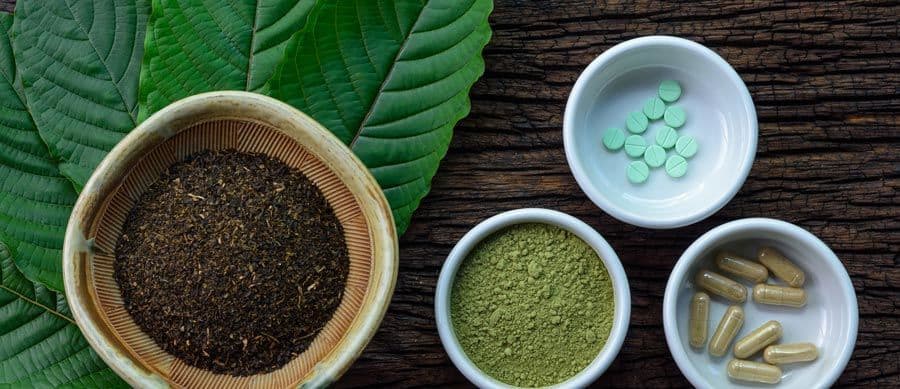Last Updated on October 11, 2025
At a Glance: What This Page Covers
- Defines kratom, how it’s used (tea, pills, powders, extracts), and why its opioid-like effects can lead to dependence and addiction.
- Explains key risks and side effects (short- and long-term), including withdrawal symptoms, liver damage, psychosis, and dangerous drug interactions.
- Clarifies legality: kratom remains legal in Texas (laws vary by state) but is not FDA-approved; public health officials caution against its use.
- Highlights why using kratom to self-manage opioid withdrawal is unsafe, especially for people with substance use histories or co-occurring mental health conditions.
- Outlines evidence-based help: medical detox, inpatient or outpatient rehab, therapy, support groups, and long-term sober living—plus special considerations like neonatal abstinence syndrome.
What Is Kratom? Uses, Side Effects, and Legality
Kratom is a plant-based substance that has become popular in the United States. Some people believe it helps with pain relief or symptoms of opioid withdrawal. However, kratom addiction is real, and it can be dangerous.
This article explains what kratom is, how it works, the risks it carries, and how to find treatment if you are struggling.










What Is Kratom?
Kratom comes from the leaves of a tropical tree found in Southeast Asia. People chew the leaves, brew them into tea, or take them as pills, powders, or extracts. Kratom contains compounds that affect the brain in ways similar to opioid drugs.
These effects may include pain relief, increased energy, or calmness. But kratom can also cause serious side effects. Those who take large amounts of kratom may develop physical dependence or addiction.
Kratom is often sold as a dietary supplement, but it is not safe for long-term use. Even small regular doses of kratom can lead to kratom long-term effects such as liver damage, psychosis, and weight loss.
Why Do People Use Kratom?
Some use kratom to relieve pain or boost focus. Others try it to avoid the symptoms of opioid withdrawal. But using kratom in recovery can cause harm. Experts strongly warn against replacing prescription opioids with kratom. or those seeking structured support without hospitalization, our outpatient drug rehab Austin TX program offers flexible, evidence-based treatment.
The National Institute on Drug Abuse reports no proof that kratom is effective for treating opioid addiction. Instead, it may increase the risk of new addiction. People with a history of substance use disorders face greater danger.
Many individuals with opioid dependence try kratom to manage cravings, but it often leads to new substance use problems.
Is Kratom Addictive?
Yes. Kratom is addictive, especially when used often or in large amounts. Over time, users may need more to feel the same effects. When they stop, they may experience kratom addiction withdrawal.
These symptoms of opioid withdrawal and kratom withdrawal include muscle aches, nausea, sleep problems, and mood swings. They can be severe, which is why medical kratom detox services is often needed.
Freedom Starts Here. Take Back Your Life Today.
Same-Day Admissions in Austin Available.
Start your detox in Austin today and take the first step toward recovery.
Symptoms of Kratom Addiction
Signs of kratom addiction include:
- Using more kratom than planned
- Spending a lot of time on kratom use or recovery
- Ignoring hobbies or responsibilities
- Wanting to quit but being unable to
- Continued use despite health problems
- Needing a higher dose of kratom for the same effect
These are signs of a substance use disorder. If this describes you, it’s time to seek help.
Side Effects of Kratom
Kratom can have both short- and long-term side effects. Short-term side effects include:
- Sweating
- Nausea
- Constipation
- Increased urination
- Dry mouth
- Drowsiness
- Itching
Long-term kratom use may cause:
- Weight loss
- Hallucinations
- Poor concentration
- Liver damage
- Anxiety or depression
- Insomnia
- Skin discoloration
- Psychotic episodes
Mixing kratom with other drugs or prescription drugs is dangerous. Kratom drug interactions may cause seizures, brain problems, or respiratory depression. People with medical conditions are at higher risk.
Kratom vs. Heroin
Kratom and heroin both act on opioid receptors, but they are not the same. Kratom comes from a Southeast Asian tree. Heroin is made from morphine, which comes from the opium poppy. Learn more about heroin addiction signs and treatment.
Kratom is sold in pills, powders, teas, and extracts. It’s legal in some states, banned in others. Heroin is illegal across the U.S.
Kratom is often used for pain, increased energy, or to ease withdrawal symptoms. Heroin is used for a recreational high. Both can lead to opioid dependence, but heroin is more dangerous and classified as a Schedule I drug. Learn more about how is heroin an opioid and why its classification matters.
How Long Is Kratom Withdrawal?
Kratom withdrawal symptoms begin 12 to 48 hours after the last dose. They usually fade within three to five days, though symptoms and cravings may last longer. You can also explore related opioid withdrawal symptoms for additional insight.
The length of withdrawal depends on the amount of kratom taken, frequency of use, and other medical conditions. Mental health issues may make recovery harder.
Is Kratom Legal?
Kratom is legal in some U.S. states and banned in others. Some label it a controlled substance. Others classify it as an illegal drug. Laws continue to change.
Currently, kratom is legal in Texas and several other states. Public health officials caution against its use. Kratom is not FDA-approved or medically regulated.
Risks of Using Kratom in Recovery
Using kratom in recovery is risky. Although legal in many areas, it may lead to relapse. Kratom creates cravings, causes withdrawal symptoms, and can trigger drug-seeking behaviors.
Some people use kratom in recovery thinking it’s safer than opioid medication. But it often leads to a return to substance use. Safer alternatives include therapy, support groups, and structured programs.
Kratom and Mental Health
Kratom addiction often occurs alongside a mental health condition like anxiety, depression, or PTSD. This is known as dual diagnosis. Treatment plans must address both issues.
People who are drug addicted may also experience stress, isolation, or trauma. Kratom use increases the risk of mental health conditions, especially in high doses or over long periods.
Neonatal Abstinence Syndrome
When pregnant individuals use kratom, their babies may be born with neonatal abstinence syndrome. This condition causes withdrawal symptoms in newborns and needs urgent care.
Treatment Options for Kratom Addiction
There are several treatment programs that can help with kratom addiction. Options include:
- Inpatient care
- Outpatient programs
- Outpatient alcohol rehab Austin TX
- Sober living
- Therapy and counseling
- Medication (if needed)
- Support groups
Most people begin with a medical detox. This process helps manage withdrawal symptoms safely. A detox center offers 24/7 medical assistance and support. Detox helps address symptoms of opioid withdrawal and prepares individuals for long term recovery. If you’re local, our drug detox Austin location provides same-day admissions and individualized care.
After detox, people usually join a rehab program. These programs use behavioral therapy, group sessions, and education to support recovery. Personalized treatment plans help people stay sober and avoid relapse.
Behavioral therapy can also address underlying mental health issues. Treatment programs may include support groups, counseling for family members, and strategies for staying sober.
Support for Recovery
Support groups like SMART Recovery or 12-step programs provide ongoing help. Many people also benefit from long-term sober living environments. We have:
- sober living in Austin
- sober living in Houston
- See all of our sober living options
Working with a treatment center also connects you to other services. These may include case management, mental health support, and help with daily life. These programs are essential in treating both substance use disorders and co-occurring conditions.
Get Help Today
If you’re struggling with kratom addiction, you’re not alone. The first step is reaching out. Recovery is possible.
Nova Recovery Center offers trusted care for kratom addiction. We provide detox, therapy, and long-term support. Our goal is to help you build a healthy, drug-free life.
Call today to speak with a medical professional. Your recovery journey can begin now.
Kratom Withdrawal, Effects, and Treatment: Common Questions Answered
What are the side effects of withdrawal from kratom?
Kratom withdrawal may cause symptoms such as anxiety, irritability, sweating, muscle aches, nausea, insomnia, and intense cravings. In more severe cases, individuals may also experience mood swings and depression, which can make recovery challenging without medical support.
Does kratom make you buzzed?
Yes, kratom can produce a “buzzed” or euphoric feeling, especially at higher doses. Users report increased energy or relaxation depending on the strain, but these effects also raise the risk of psychological dependence.
Is kratom a full opioid?
Kratom is not classified as a full opioid, but it does act on opioid receptors in the brain. Its alkaloids mimic some opioid effects, which is why it can cause dependence and withdrawal similar to opioids.
Does kratom affect sexual performance?
Some users report sexual side effects from kratom, including changes in libido or erectile function. These effects vary, but long-term use may contribute to hormonal imbalances and other health risks.
What is one of the first signs of kratom withdrawal?
Early signs often include irritability, restlessness, and anxiety. These may appear within 12–24 hours after the last dose and can progress to physical discomfort and sleep disturbances.
How long do kratom withdrawals last?
Withdrawal typically peaks within the first 2–4 days and can last up to a week. However, some individuals may struggle with lingering cravings and mood changes for longer periods.
What drug has the worst withdrawal symptoms?
Among addictive substances, opioids like heroin and prescription painkillers are considered to have the most severe withdrawal symptoms. While kratom withdrawal can be difficult, it is generally not as life-threatening as opioid or alcohol withdrawal.
Is Suboxone used to treat kratom addiction?
In some cases, medications like Suboxone (buprenorphine/naloxone) may be used to manage kratom withdrawal and cravings. Treatment should always be guided by a medical professional experienced in addiction recovery.
What are the long-term effects of kratom?
Chronic kratom use can lead to liver damage, digestive issues, dependence, and mental health problems such as anxiety or depression. Long-term effects remain under study, but evidence shows significant health risks with heavy use.
What treatment is available for kratom addiction?
Treatment often includes medically supervised detox, behavioral therapies like cognitive behavioral therapy (CBT), support groups, and aftercare programs. Facilities such as Nova Recovery Center provide comprehensive treatment for kratom dependence and co-occurring disorders.
Other Drug and Alcohol Rehab Locations
Outside Austin? Explore outpatient rehab in Houston or our San Antonio IOP for the same quality care.
Medical Disclaimer
The information provided on this page is for educational purposes only and should not be used as a substitute for professional medical advice, diagnosis, or treatment. Kratom and other substances discussed herein may carry significant health risks and should only be used or discontinued under the guidance of a licensed healthcare professional. If you are experiencing withdrawal symptoms, adverse reactions, or a medical emergency, call 911 in the United States or seek immediate medical assistance. For mental health or substance use support, you can contact the 988 Suicide & Crisis Lifeline, available 24/7.
Nova Recovery Center Editorial Guidelines
By instituting a policy, we create a standardized approach to how we create, verify, and distribute all content and resources we produce. An editorial policy helps us ensure that any material our writing and clinical team create, both online and in print, meets or exceeds our standards of integrity and accuracy. Our goal is to demonstrate our commitment to education and patient support by creating valuable resources within our realm of expertise, verifying them for accuracy, and providing relevant, respectful, and insightful data to our clients and families.
- National Institute on Drug Abuse. (2022). Kratom. NIDA. Retrieved October 5, 2025, from https://nida.nih.gov/research-topics/kratom.
- U.S. Food and Drug Administration. (2025, September 25). FDA and Kratom. FDA. Retrieved October 5, 2025, from https://www.fda.gov/news-events/public-health-focus/fda-and-kratom.
- Anwar, M., Law, R., & Schier, J. (2016, July 29). Notes from the field: Kratom (Mitragyna speciosa) exposures reported to poison centers — United States, 2010–2015. MMWR Morbidity and Mortality Weekly Report, 65(29), 748–749. Centers for Disease Control and Prevention. Retrieved October 5, 2025, from https://www.cdc.gov/mmwr/volumes/65/wr/mm6529a4.htm.
- O’Malley Olsen, E., O’Donnell, J., Mattson, C. L., Schier, J. G., & Wilson, N. (2019, April 12). Notes from the field: Unintentional drug overdose deaths with kratom detected—27 states, July 2016–December 2017. MMWR Morbidity and Mortality Weekly Report, 68(14), 326–327. Centers for Disease Control and Prevention. Retrieved October 5, 2025, from https://www.cdc.gov/mmwr/volumes/68/wr/mm6814a2.htm.
- National Center for Complementary and Integrative Health. (2022, April). Kratom. NCCIH (NIH). Retrieved October 5, 2025, from https://www.nccih.nih.gov/health/kratom.
- Substance Abuse and Mental Health Services Administration. (2024, October 11). TIP 63: Medications for Opioid Use Disorder (Full document). SAMHSA. Retrieved October 5, 2025, from https://www.samhsa.gov/resource/ebp/tip-63-medications-opioid-use-disorder.
- U.S. Drug Enforcement Administration. (n.d.). Kratom (Drug Fact Sheet). DEA. Retrieved October 5, 2025, from https://www.dea.gov/factsheets/kratom.


